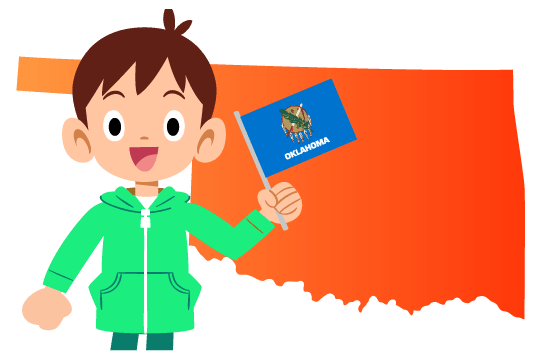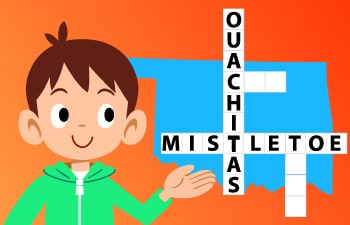Did you know that “Oklahoma” is a combination of two words in the Choctaw language that means “red people” and that is the home to the most Native Americans of any state? Did you also know that the parking meter was invented in Oklahoma and that the state is the site of the famous 101 Ranch, which became known for the international Wild West shows that were filmed there? Did you know that Oklahoma City is the location of Deep Deuce, an African American business and cultural district often visited by world famous blues and jazz musicians, or that nineteen of Oklahoma’s Choctaw people served as Code Talkers to send and receive coded messages in their native language during World War I?
With a population near four million, the state is one of the largest producers of petroleum, natural gas, and crude oil. In this article you’ll learn interesting facts about Oklahoma, including an Oklahoma history timeline, geography facts and more. Time4Learning members can download our list of PreK-12 interactive activities that align with your study of Oklahoma. Here are a few Oklahoma facts for kids:
Oklahoma Fast Facts
|
Became a State: |
November 16, 1907 |
|---|---|
|
Order it Joined the Union: |
46th state |
|
State Capital: |
Oklahoma City |
|
State Abbreviation: |
OK |
|
Border States: |
|
|
State Flag: |
|
|
State Song: |
|
|
State Flower: |
Oklahoma Rose |
|
State Nickname: |
The Sooner State |
|
Notable Oklahomans: |
|
Historical Facts About Oklahoma
Although a newer state in the union, Oklahoma’s human history is one of the oldest with evidence dating as far back as 9500 BCE. Archaeological finds show evidence of pottery, textiles, sculptures, and metal items beginning around 700 CE. The Spiro Mounds, now an archaeological site, were the location of a thriving trade center from 900-1300 CE. Eventually, the area was inhabited by Native American tribes such as the Caddo, Comanche, Kiowa, Osage, and Plains Apache.
The Oklahoma region was first explored by Francisco Vásquez de Coronado who was looking for the legendary cities of gold in 1541. Spanish and French explorers and traders then came to the area in the 1700s, and both Spain and France controlled parts of the region for a time. In 1800, French emperor, Napoleon Bonaparte, acquired what is now Oklahoma from Spain, and then later sold it as part of the Louisiana Territory in 1803.
By the 1830s, Oklahoma became the location of “Indian Territory,” to which many Native Americans were relocated. Beginning in 1827, over 23,000 Muscogee people were moved from Alabama and Georgia to Indian Territory. In 1830, US Congress passed the Indian Removal Act, which mandated that all Native Americans east of the Mississippi be removed. Other Native American people, like the Choctaw, then began their move to Indian Territory.
Indian removal culminated in the infamous Trail of Tears, where 4,000 Cherokee people (one-fifth of the population) lost their lives while on their 800-mile trek to Indian Territory. Settlers then came to parts of Oklahoma in 1889, including some who were able to claim land before it was officially open to them. Those settlers were called “sooners,” leading to the state’s nickname of The Sooner State. Part of the Indian Territory became “Oklahoma Territory” in the 1890s, and then the two territories were combined again to form the 46th state in the union, in 1907.
Read the Oklahoma history timeline below to learn important Oklahoma history facts through the events that occurred in the state.
1541
Francisco Vásquez de Coronado of Spain explored the region1601
Spain’s Juan de Oñate found gold in the Oklahoma Panhandle1682
Rene Robert Cavelier, Sieur de la Salle claims the Louisiana Territory, including Oklahoma, for France1762
Spain acquires Oklahoma from France after the Seven Years’ War1796
Jean Pierre Chouteau established the Chouteau Trading Post (near Salina) as the first permanent European settlement1800
Napoleon Bonaparte acquired the region from Spain through the Treaty of San Ildefonso1803
US acquired Oklahoma through the Louisiana Purchase1804
Meriwether Lewis and William Clark began their famous exploration of the former Louisiana Territory1811
George Sibley and his Osage guide, Sans Oreille, discovered the Great Salt Plains (near Jet)1821
Sequoyah completed a syllabary showing the writing system of the Cherokee language; first school building was built at Union Mission (near Chouteau)1824
Fort Gibson and Fort Towson were built to protect the removed Native Americans in Oklahoma, known as the Indian Territory1827
Muscogee (Creek) people were forcibly removed from Alabama and Georgia to Oklahoma, known as the Indian Territory1830
the US Congress passed the Indian Removal Act, requiring removal of all Native Americans east of the Mississippi1838
Trail of Tears, thousands of Native American lives were lost when the Cherokee began their 800-mile trek from Tennessee, Alabama, North Carolina, and Georgia into Oklahoma1843
Cherokee Principal Chief John Ross calls the International Indian Council, a meeting of removed tribes, in order to renew customs and revive alliances1861-1865
American Civil War, large numbers of removed Indian tribes sided with the Confederacy (and only smaller groups sided with the Union)1866
First of more than 50 all-black towns were created by emancipated (freed) slaves in present-day Oklahoma1868
Battle of Washita, when George Custer attacked the Cheyenne camp and killed over a hundred tribe members1870
Missouri, Kansas, Texas Railway (KATY), laid the first railroad tracks in Indian Territory1889
First Land Run, when “Sooners” (those entering early) and other settlers came to the region to claim more than 1.9 million acres in central Oklahoma1893
Cherokee Outlet Land Run, the largest and most chaotic land run when over 100,000 people set out to claim 6.5 million acres in northwestern Oklahoma1901
Last major land run, opening the Wichita, Comanche, Kiowa, and Apache lands for settlement by lottery1905
Sequoyah Convention occurred where tribal leaders met to discuss the formation of a separate state for Indian tribes and draft a constitution (that would later be a guide for the Oklahoma state constitution)1906
Final land opening occurred in the Osage and Kaw lands1907
Oklahoma became the 46th state in the US1910
State voters choose Oklahoma City as the new capital of Oklahoma.1995
Terrorist attack on the Murrah Federal Building in downtown Oklahoma CityBring history and geography to life with Time4Learning’s interactive online social studies curriculum for grades 2-12.
Oklahoma Geography Facts
Oklahoma’s geography varies across the state. The northwest contains the dry, flat grasslands of the High Plains and then the Gypsum Hills, capped with up to 20 feet of the soft mineral, as you move east. The northeast includes the ridges, valleys, caves, and sinkholes of the Ozark Plateau and the Ozark mountain range, as well as the Prairie Plains, with its fertile farmlands. In the central and south-central regions, you will find the Red Beds Plains, the largest land region in Oklahoma consisting of shale and red sandstone, and the low, rocky hills of the Sandstone Hills. Below the Sandstone Hills are one of North America’s oldest ranges, the Arbuckle Mountains. Although eroded (worn down), they are 1.3 billion years old!
The southeast contains the Ouachita Mountains and part of the Ouachita National Forest, and the Red River Valley shares its fertile soil and forests with Texas along the border. The southwest contains the state’s largest wildlife refuge, the Wichita Mountains National Wildlife Refuge. This geographic variety allows for the existence of a variety of wildlife including pronghorn antelopes, armadillos, bison (the state animal), coyotes, roadrunners and scissortail flycatchers (the state bird), as well as copperhead snakes and American alligators.
Check out this map of Oklahoma to start getting familiar with the state. Then read through the following Oklahoma geography facts. Print out the map of Oklahoma provided below and add these items to the map.
- The Oklahoma Panhandle is a 34-mile-wide stretch of land that extends west beneath Colorado.
- Oklahoma has the largest population of Cherokees in the Nation.
- Oklahoma is bordered by Colorado and Kansas to the north, Missouri and Arkansas to the east, Texas to the south and west, and New Mexico west of the panhandle.
- The capital of Oklahoma City lies near the middle of the state.
- The Ozark Plateau is located to the east of Tulsa.
- The Wichita Mountains are found in the southwest region of the state, with the Arbuckle Mountains just southeast of those.
- The Ouachita Mountains are in the southeast corner of Oklahoma.
- The Arkansas River crosses the northern border with Kansas near the center of Oklahoma.
- The Canadian River crosses the western border with Texas and flows near Oklahoma City.
- The Red River forms part of the border with Texas.
- Lake O’ the Cherokees can be found in the northeast corner of the state.
- Lake Texoma is located in the southeast region of the state, near the Texas border.
- The highest point in Oklahoma is Black Mesa (4,978 feet), located in the Panhandle region, close to the western borders with Colorado and New Mexico.
- The lowest point in the state is on the Little River (298 feet), south of Shawnee in the southeast corner of the state.
Oklahoma State Map
Download our FREE Oklahoma state map printable. Use it as a coloring page or use it to plot the state’s geographical features.
Activities for Children in Oklahoma
How else can you learn fun facts about Oklahoma? A visit to some of the state’s unique sites will help. Homeschoolers in Oklahoma can take a day trip while out-of-towners may be able to plan an extended stay. If you can, schedule a trip during the annual Red Earth Native American Cultural Festival in Oklahoma City, or here are a few other ideas to help you learn some Oklahoma facts:
- Lost Creek Safari (Stillwater): Visit this newer exotic animal park to see such creatures as deer, birds, zebras, hairless cats, serval, cattle, donkeys, cavies, lemurs, tamarins, and black-handed spider monkeys. Come on the weekends or make a reservation for a weekday visit.
- National Cowboy & Western Heritage Museum (Oklahoma City): Learn about the Old West through a model of an old town, a kid-sized corral, and Native American artifacts. Watch for annual events and special exhibitions. Right now, admission is free on Wide Open Wednesdays thanks to the generosity of Oklahoma Ford Dealers.
- Philbrook Museum of Art (Tulsa): See the scenic gardens as you approach the original location or visit the downtown location. Explore the collections and exhibits to see modern and contemporary art; African, Asian, European, and American art; Native American pieces; photography; decorative arts; and antiques.
- Stafford Air & Space Museum (Weatherford): Explore over one-acre of exhibits honoring General Stafford, early aviation (air travel), rocket engines, space exploration, space shuttle history, and modern aviation. Watch for the annual Wings Over Weatherford celebration with warbird fly-ins and aircraft rides and other family fun.
- Oklahoma City National Memorial and Museum (Oklahoma City): Walk through the grounds at the site of the 1995 bombing of the Alfred P. Murrah Federal Building. See the bronze Gates of Time and the Survivor Tree, honoring the city’s ability to recover, and then pause at the outdoor Field of Empty Chairs. There is an admission fee for the museum, the grounds are always open and free to experience.
Looking for more things to do with your kids in Oklahoma? Check out this post full of field trip ideas in Oklahoma!
Oklahoma Freebies and Deals for Homeschoolers
You can learn more Oklahoma facts and information by visiting some of these low or no cost sites. In addition to visiting one or more of Oklahoma’s 32 state parks, below are some other ideas:
- Fred Jones Jr. Museum of Art (Norman): Enjoy the European, Asian, and Native American artwork, including pieces by Vincent van Gogh and Georgia O’Keefe. This University of Oklahoma museum has more than 20,000 objects in its permanent collection. Due to a gift from the University Athletics Department, admission is always free.
- Salt Plains National Wildlife Refuge (Cherokee): Dig for hourglass-shaped selenite crystals (the state crystal) on the salt flats and take them home. The salt plains are open from April through October, and the whole family can dig for free from sunrise to sunset.
- Historic Route 66 (Various Locations): Take a drive along the largest drivable stretch of Route 66 in the US. Discover unique free roadside stops such as the Blue Whale of Catoosa, the Totem Pole Park of Chelsea, and the Round Barn and Pops giant soda bottle in Arcadia. Visit the Seaba Station Motorcycle Museum in Warwick. Pack a picnic lunch and take lots of photos.
- Keystone Ancient Forest (Sand Springs): On select Saturdays, enjoy this 1,360-acre nature preserve with ancient forests that include 500-year-old post oaks and 300-year-old cedars. Hike one of the trails or watch wildlife on Keystone Lake. In addition to migratory birds and over 80 species of butterflies, try to catch a glimpse of the forest’s deer, mountain lion, bobcat, or American eagle. There are no entrance fees.
- Wichita Mountains National Wildlife Refuge (Indiahoma): Hike, mountain bike, or rock climb in the oldest wildlife refuge in the US. See elk and bison and other wildlife. Take a tour, have a picnic, or go camping. Hunting and fishing are also allowed. There are no entrance fees.
Oklahoma Learning Games for Children
Now that you know some interesting things about Oklahoma, test your Oklahoma facts knowledge with these free games and activities:













